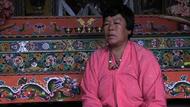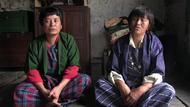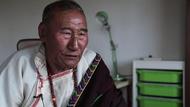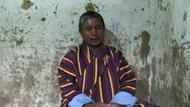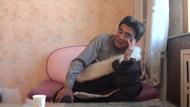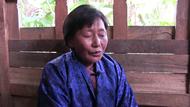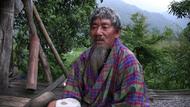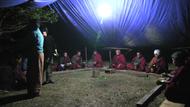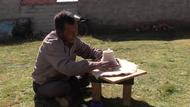Video Overview
Dr. Leslie Blackhall, an American physician, talks with first-year medical students about functional physiology, the Tibetan medical understanding of the body, and the concept of the three humors in Tibetan medicine.
- Dr. Leslie BlackhallIt has uh, uh, uh a theory, a physiology, I think the way I put it, the physiology of Tibetan medicine is similar to Ayurvedic in that they look at...they divide the functioning in the body into what's called, um, humors.
- They call them humors here; it's really sort of a bad translation. But we're going to go through what that means.
- But, but before the physiology, you know, before...when you guys do physiology, it assumes a lot of stuff, right? It assumes, like, you know about atoms and molecules and, and, you know, all those, periodic table of the elements and things like that.
- So, the periodic table of the elements that most Chinese medicine uses and also this uses is the idea of the Five Elements. And have you guys ever heard of the Five Element Theory?
- So, its that the, sort of the material world can be broken into these five principals: Earth, Water, Fire, Air / Wind, and Space. Ok?
- In a way, the translations also for us are hard to wrap our minds around because Earth doesn't mean like, "mud" you know what I mean? And wind doesn't mean like *blows* you know? The wind, they, they are inb a ways metaphors.
- So, earth is the principal of solidity, Ok? It sort of, the principal of solidity. Water is cohesion and liquidity. Fire is ripening or maturing. Wind is vitality and movement, and sort of the qi or the vital force is often, sort of, very closely associated with that, but also movement in general. And in the body it is sort of the nervous system, right? That causes you to be able to move and also to think.
- And space is the fifth one, which of course provides the physical location for all, all of the other four.
- So, just bear that in mind for a second.
- Um, the three, um, basic principals of the body are wind, bile, and phlegm, Ok? Now, what I want to say is, what's going to be different for you and what took me a while when I was studying Tibetan Medicine, is that we're used to thinking of the body anatomically.
- Right? So when you do anatomy, you sort of take your scapel and you cut it open and you look for the nerves and the blood vessels and the muscles and the fat and the formaldehyde and, you know, all the other junk.
- And we're used to thinking of things as happening anatomically, and we're used to then--when we think about a disease--we think about where it is and where it started and what happened to the receptors.
- But Tibetan Medicine, like also I think this true of Ayurvedic and Chinese medicine, tends to think functionally. So, when they descibre the body, when they're describing wind, bile, and phlegm, they're not, first of all, phlegm is not refering to like that stuff you coughed up this morning, you know, when you woke up, or whatever.
- And bile is not that stuff in the gallbladder, you know. And wind isn't, you know, whatever the air I breath in. These are descriptions of functions of the body, Ok?
- So, and to give you an example of how and to, what it means is that it really is a whole different way of describing the body, right? In terms of function rather than structure.
- And to give you an example of how this plays out in western medicine, I, my son, when he was little, one of my sons, the older one, we went down a slide and it was really a bad mom moment and he put his leg out and you know, physics, right? We were going down and the leg didn't go down and he broke his leg.
- He was a year and a half old. And, um, anyway, you know, he got a cast on and bone growth being what it is at a year and a half, in two weeks the cast was off.
- However, he continued to limp, I mean, and he always has a cough, he's sort of a guy with allergies. And his foot was totally turned out and he walked along coughing with his limp, he looked like Tiny Tim, it was really awful. [laughter].
- And I was so worried about him, he was my first child and I just thought he was deformed or something. And I kept bringing him to the orthopedist, and you know what kept doing? They kept taking x-rays, and they said "The bone is healed."
- I'd say, "The bone is healed!? But look at my son! He's like Tiny Tim, you know?" Clop clop [cough cough]
- You know, this is not right! And they just would look at me and say, "But the bone is healed." Ok?
- They need to look at function rather than structure. And similarly, there's this story that Arthur Kleinman told me, and I don't know if it is true, but, you know, among the first people, the Westerners who went to China, were the missionaries, right? And they often sent medical people.
- And the medical people found themselves irritated that the whole Chinese medicine thing, and all this stuff with qi, and the channels and whatever it was, because clearly this stuff didn't, was just a fabrication of it. You know, people's imagination.
- And so, they decided to prove to the Chinese doctors that there was no such thing as qi. And no such thing as, sort of, um, meridians by having them come to an autopsy.
- So, they brought the Chinese doctors in to the autopsy, they autopsied the body and they showed them, "No. Where's the meridian? No meridian."
- So, and the doctors looked, the Chinese doctors looked at the western doctors, and they both just sort of looked at each other and the Chinese doctors went home and then they sent a little note, you know, saying, "We're so sorry that you were unable to find, you know, the meridian through your autopsy."
- Which made the western doctors think that these people were just ao dogmatic, you know, that they couldn't see truth when it was in front of them. But the truth is that these things are not felt to be the sort of thinga that you see, you know, visually.
- They're function. They are not structure. So, here's a case of people just talking, right, totally and not getting it.
- And are these three things, um, wind is basically, um, ok... basically, I would say that wind is has to do with the functions of the nervous system in the human body, ok?
- Such as motor strength, your sense organs, and also supporting consciousness. So anything you do that requires movement, um, including the moving of the mind, um, and anything that the, so, the sensort and motor nervous sytem.
- So, any disease that we would see, like ALS, right? Lou Gehrig's disease, or people become blind--these are all due to defects in the lung (rlung)
- And many types of mental illness are also felt to be related to lung (rlung). They're felt to be nervous systtem problems, and I'll talk a little bit more about that later.
- And then the lung (rlung), the function of the lung (rlung), um, is also which is also the Tibetan word for "wind," which is translated as "wind" usually, is broken down into five sub-types.
- And actually, we often, you could break these down further, but just to give you an idea of why I'm saying this corresponds to the nervous system, and, uh, is, or to nervous system functioning, the functions we usually ascribe to the nervous system, is that there's the wind that controls the breathing, the wind that controls speech, the wind that controls muscular motion.
- There's a wind assists digestion, and then there's, um, um, winds that control excretion and sexual functioning and things like that.
- And, so you can see, that what we, you know, whereas we might function, you know look at these things in a more anatomical way, this is doing things by function, which, and they're dividing even and dividing up the winds in terms of their functioning.
- Ok? Also, um, the other thing that they, there's a tendencey to do is to look at whole physiology and say, "Are you basically sort of a wind type of person? Do you tend to have a predominance of this humor? Are you a bile type of person? Are you a phlegm type of person?"
- Now, I've given, I'm going to go through each of the three humors and talk to you about what they do, but I want to actually step back and say that in Tibetan Medicine the, um, definition of, sort of, mundane health, the job of the doctor is to keep these three humors balanced, Ok?
- So, the three humors are basically creating illness by being out of balance in one way or the other.
- And, then we talk about how they get unbalanced, we might want to go, we probably will go back to those five elements were were talking about before.
- Um,
- And also to say that in the beginning, we're talking about these three humors--wind, bile, and phlegm--which are associated with these physiologic functions, right? They are also associated with, each of them, with mental functions--that is with, sort of, basic emotional, emotions, and I also am going to go into this, this is how it ties into Buddhiset philosophy and understanding.
- So, wind is the, um, associated with...and it is associated with the element wind, Ok? And it is associated with the basic mental dysfunction or poison of greed or desire.
- Ok? Bile, which is associated with the element of fire, is associated with hatred, basically with hatred.
- And phlegm, which is water and earth, is associated with ignorance. So, I'm just going to, I want to point out that one of the differences, basic differences between this physiology is that there is a complete, um, from the beginning association between mental states and physical states.
- So, an imbalance in your wind can lead to mental imbalances, but also, you know, greed or desire, for example, one of the causes of a wind disorder is unrequited love or in general wanting, you know, longing after something you can't get.
- And obsessing about and longing, just continually wanting something that you can't get, like when you were trying to get into medical school and, you know, whatever it was.
- You were setting yourself up for a wind disorder, but on the other hand, the other types of things that might cause a wind disorder would be things that increase the element of wind, so that there are foods are associated with the element of wind that if you are eatting those too much they would, could increase your winds and even make you more agitated and nervous.
- So, it works both, in both those directions, does that make sense?
- Ok.
- All right, let's...
- Ok, and so somebody, um, who, you know, has a general physiology where they tend to be prone to imbalances of wind are usually thin, they're often cold, they tend to be a little bit nervous or agitated, and they tend to be wanting things a lot, you know,
- Maybe very ambitious and always trying to go out and get things, you know, or maybe even greedy or just sort of longing after things.
- And so that's, sort of, somebody you could say would be a set-up to get a wind disorder and would have to be more careful than other people about what they ate in terms of, um, you know, involving themselves with not eating to many foods that would inflame their winds.
- Because they're basic body type makes them prone to this illness.
- Ok, let's just talk about bile for a second, and it is sometimes refered to as vital energy, and now, some of the things I'm telling you are things that, you know, I, just atepping back one second, some of the stuff that I'm telling you, for example, the wind being associated with the nervous system or with, with that type of functioning are things, are translations that I have attempted to make.
- And there may be those who would disagree with the way I'm doing this, but one of my feelings is that, you know, one of the more interesting things about alternative medicine, to me, as I told you I'm not so much interested in whether this one works here or there, you know?
- As much as I'm interested in looking at, you know, when you take, if you put Yeshe Dhonden in a room and have him do his thing, which I'll tell you what, you know, he feels your pulse, he stirs up your pee-pee, he looks at your tongue, he asks you some questions, sometimes he'll feel other parts of your body, but basically it is the pee-pee and the pulse and the [sticks out her tongue] stick out your tongue.
- And his way he describes disease, what is in there that corresponds to the way, in what area can we make a correspondence, I'm really, I think that's very interesting.
- To look, since we know we're looking at mainly an anatomical-based system versus a functional-based system, even so, where can we see correspondences and where do we not see correspondences.
- And where does one work better than the other?
- So, anyway, sometimes they refer to bile or tripa (mkhris-pa) as vital energy. And basically, digestive and insomatic reactions are a function of bile, and...
- One way I want, that I sometimes use to explain, sort of, the wind, bild and phlegm thing is think about the functions of your stomach, right?
- So, you swallow some food, and to swallow it, your esophagus has to conract and then to break the food up, your stomach has to churn around. The contractions and the churning? That's wind. Ok? The wind causes your stomach to bump up and down, and contract, and break that food into little pieces.
- Then, there's the bile would be the digestive enzymes, I mean the function of the bile would be to have the digestive enzymes that sort of really break things down.
- Whereas the phlegm would be the fluid in the stomach that sorts of holds it all together so that the enzymes can get there and the... it can mush around in your stomach...and that's the technical term, "mush around."
- You haven't gotten to that part of your physiology yet. [laughter].
- Um, oh, so does that make sense? Does that help you see how those three different things work together?
- So, but actually when you look at some of the types of bile, I find, you know, I find that it is a difficult thing sometimes. So, there's the digestive bile, there's the bile that transforms color, like, for example, jaundice, you know people who are jaundiced would be having a problem with this type of bile.
- And, you know, that is actually sort of a correspondence where the bile that we know about and the physiological function of bile in Tibetan Medicine overlap.
- And then there's actually a bile that's responsible for vision, one that's responsible for the texture and health of the skin, so it's...those are some of the bile functions.
- Ok?
- And, as I said before, and this you can see elements of this because there is clearly correspondence between this and, sort of, the ancient Greek humoral theories, right? And this idea of the bilious personality, that's someone who gets right in the face and who is sort of heavy and they get angry a lot and they tend to get red in the face and scream at you, you know? Get right in your face an they're always, sort of, furious.
- That's the bile personality here too. And then there's phlegm, it's the inert substances in the body. There's the supportive phelgm, it's sometimes called the supportive phlegm that's in your chest, and it might be associated with, you know, basically phlegm and saliva.
- They're the inert fluids in the stomach, there's a phlegm associated with the sense of taste, and there's a, you know, joint fluid type of phlegms.
- So, phelgm is associated with ignorance or, sort of, prejudice. People who are like that. And they tend to be heavy and sleep alot. You know, sort of, people who are overweight and, sort of, lethargic.
- Ok, so, um...
 Loading ...
Loading ... 